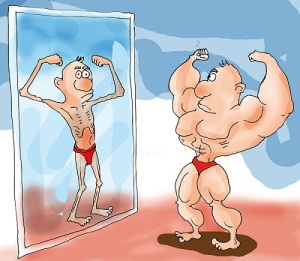This post is part of a series of guest posts on GPS by the graduate students in my Psychopathology course. As part of their work for the course, each student had to demonstrate mastery of the skill of “Educating the Public about Mental Health.” To that end, each student has to prepare two 1,000ish word posts on a particular class of mental disorders.
______________________________________________
Body Image, Muscle Dysmorphia, and Steroids by Scott Sims
 Body Dysmorphic Disorder (BDD) is a disorder that is characterized by preoccupations about perceived physical defects. These “defects” are often little more than delusional thinking, but give rise to compulsive rituals such as excessive grooming and mirror checking. While these symptoms are impairing enough, what happens when they are bad enough to override rational thought? Such is often the case in severe Muscle Dysmorphia (MD), a disorder that almost exclusively effects males. Muscle Dysmorphia (sometimes called “bigorexia“) is an obsessive-compulsive related disorder in which classic obsessions and compulsions are replaced with preoccupations. In this case, the preoccupation is on achieving maximum muscle size, which in turn can lead to several unhealthy compulsions, including anabolic steroid abuse.
Body Dysmorphic Disorder (BDD) is a disorder that is characterized by preoccupations about perceived physical defects. These “defects” are often little more than delusional thinking, but give rise to compulsive rituals such as excessive grooming and mirror checking. While these symptoms are impairing enough, what happens when they are bad enough to override rational thought? Such is often the case in severe Muscle Dysmorphia (MD), a disorder that almost exclusively effects males. Muscle Dysmorphia (sometimes called “bigorexia“) is an obsessive-compulsive related disorder in which classic obsessions and compulsions are replaced with preoccupations. In this case, the preoccupation is on achieving maximum muscle size, which in turn can lead to several unhealthy compulsions, including anabolic steroid abuse.
We all know some of the side effects of steroids, such as breast enlargement and acne in men. These are minor, however, compared to the serious and life threatening side effects such as heart attack or cancer of the liver. Steroid abuse alters the natural release of hormones in the human body, leading to changes such as testicular atrophy, male-pattern baldness, and gynecomastia. All of these side effects occur alongside an unnatural rate of muscle growth that can place massive amounts of stress on the stabilizing joints and tendons of the body that aren’t prepared to support such fast muscle acquisition. The people taking anabolic steroids do not have the oversight of a medical professional to monitor their use. Patients with muscle-wasting diseases such as AIDS or perhaps certain types of cancers can often benefit from using medically appropriate doses of steroids. The problem with non-medical steroid abuse is that the doses are often 10 to 100 times higher than those recommended by medical professionals.
In a person with MD, the need to use these steroids would feel stronger than someone without MD. The delusional thinking patterns of these individuals leads to a cycle that is hard to break without professional help. A person with MD will never be satisfied with their physical appearance. The nature of the disorder is to center in on a perceived defect (one that often can’t be seen or noticed by outside observers). It is a spotlight effect of the type often experienced in adolescence in which one believes that their defect is extremely visible to others, and causes clinically significant levels of distress in the case of MD. The compulsions that are seen in MD include spending hours in the gym working out, hundreds and thousands of dollars on supplements and trainers, and committing to deviant eating patterns in order to gain mass and muscle. As our society begins targeting individuals at an earlier age with advertisements designed to prey on body image and self-worth, these individuals will be at an increased risk for developing body image disorders such as MD. While it is true that not all individuals with MD will engage in steroid abuse, it seems that such a disorder would predispose these individuals to this type of substance abuse.
In a study done in 2000, male weightlifters were contrasted with weightlifters who met criteria for MD. Those who could be classified as “dysmorphic” often had poor insight (1 in 10 actually had zero insight) into the way they actually looked and the way that others perceived them. More than half reported thinking about their muscularity for at least 3 hours every day, as well as feeling like they had little to no control over their compulsive weightlifting and dieting. They also had a higher prevalence of steroid use. For these individuals, the prospect of appearing in public where they might be judged by others was terrifying because they thought they might be mocked for their perceived “smallness” (when in fact few if any of them were actually small). Their fear of social persecution justified the extreme means many of them went to in order to try and achieve their ideal body, which often led them to steroid use.
 It is hard to escape the social pressures to look a certain way, especially with the advent of mass media. With the focus for many years on how women are shamed into a certain body ideal, the way that men are targeted and shamed seems to have fallen by the wayside. A disorder like MD can bring that type of awareness to the forefront where it belongs. We are constantly bombarded with the “ideal” male form, whether it’s Superman or those dudes from 300 making the rest of us look bad. Most of us can see these individuals and understand that it is their livelihood that counts on them looking a certain way. Here is an article that describes the great lengths that Henry Cavill went to in order to become the Man of Steel. Here is another that describes the grueling training that the guys from 300 went through to become war ready Spartans. Notice anything? Maybe you noticed that no normal person without a multimillion dollar studio backing them could ever hope to commit to regiments like that. Or maybe you noticed that after they were done working out they had a personal chef make their meals for them before they went off to do 3 hours of fight training because it’s their job. You noticed that because you don’t have MD. The person with MD would take in the image of those individuals on the big screen and internalize them. When they looked in the mirror there would be no way that they stacked up. They would then spend hours in the gym, compulsively track every calorie that went into their body, and make sure they were using all the supplements they could to achieve muscularity. The problem is that they would never achieve it. There is no endgame for a person with MD. It will never be enough, no matter how big they get or what they have to do to get that big. This is what could drive a person to take anabolic steroids, and take them in an irresponsible manner. Awareness and understanding could go a long way to identifying young men who could benefit from treatment, and potentially save them from the devastating consequences of steroid abuse.
It is hard to escape the social pressures to look a certain way, especially with the advent of mass media. With the focus for many years on how women are shamed into a certain body ideal, the way that men are targeted and shamed seems to have fallen by the wayside. A disorder like MD can bring that type of awareness to the forefront where it belongs. We are constantly bombarded with the “ideal” male form, whether it’s Superman or those dudes from 300 making the rest of us look bad. Most of us can see these individuals and understand that it is their livelihood that counts on them looking a certain way. Here is an article that describes the great lengths that Henry Cavill went to in order to become the Man of Steel. Here is another that describes the grueling training that the guys from 300 went through to become war ready Spartans. Notice anything? Maybe you noticed that no normal person without a multimillion dollar studio backing them could ever hope to commit to regiments like that. Or maybe you noticed that after they were done working out they had a personal chef make their meals for them before they went off to do 3 hours of fight training because it’s their job. You noticed that because you don’t have MD. The person with MD would take in the image of those individuals on the big screen and internalize them. When they looked in the mirror there would be no way that they stacked up. They would then spend hours in the gym, compulsively track every calorie that went into their body, and make sure they were using all the supplements they could to achieve muscularity. The problem is that they would never achieve it. There is no endgame for a person with MD. It will never be enough, no matter how big they get or what they have to do to get that big. This is what could drive a person to take anabolic steroids, and take them in an irresponsible manner. Awareness and understanding could go a long way to identifying young men who could benefit from treatment, and potentially save them from the devastating consequences of steroid abuse.
